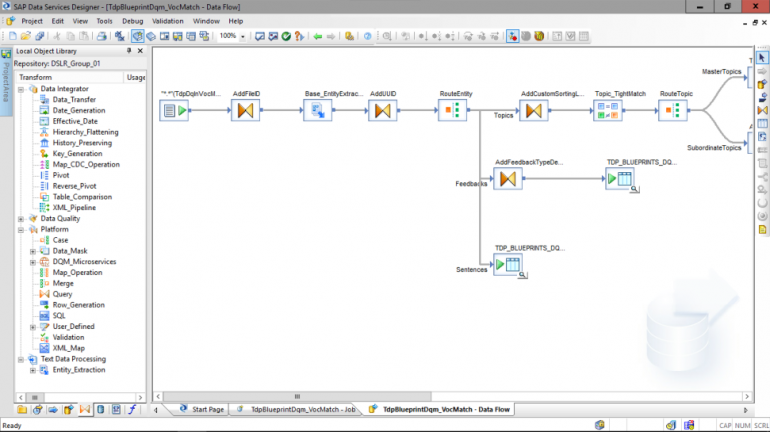
Oracle Data Integrator and SAP Data Services both offer data integration services. We compare the features of the two products to understand how effective they are as data integration tools.
Oracle Data Integrator

Oracle Data Integrator provides a data integration platform that handles high-performance batch loads, high volume, service-oriented architecture (SOA) enabled data services, event-driven trickle-feed integration processes and more data integration requirements. It offers on-premise and cloud services and delivers distinctive extract, load and transform technology that lowers the cost of data integration and enhances performance, even across disparate systems.
ELT architecture for high performance
The extract, load, transform architecture of the enterprise edition of Oracle Data Integrator leverages heterogeneous big data engines or relational database management systems (RDBMS) to transform and process data. This results in enhanced performance and optimized scalability with lower general costs. The ELT architecture of this data integration tool also generates native code for disparate big data engines such as SQL, PySpark, Pig Latin or HiveQL and RDBMS to avoid reliance on a conventional extract, transform load server.
SEE: Hiring Kit: Database engineer (TechRepublic Premium)
Heterogeneous system support
With Oracle Data Integrator Enterprise Edition, users enjoy heterogeneous support for third-party platforms, data sources and data warehousing applications. This data integration tool leverages optimizations for Oracle Database to carry out ELT data transformation, movement and data quality and standardization tasks. Oracle Data Integrator Enterprise Edition is also extensively optimized for mixed technologies like targets, applications and sources.
A high-productivity designer paradigm for data integration
To enhance user productivity and user experience, Oracle Data Integrator Enterprise Edition created a declarative flow-based user interface that merges simplicity and ease of use with extensibility and flexibility of configurable flows. This combination shortens implementation times by simplifying standard data integration design and deployment instances. This allows users or developers to focus on describing what to do as opposed to how to do it. The data integration tool can reuse mapping logic during development to simplify developers’ approaches to creating solutions.
Knowledge modules for flexibility and extensibility
The architecture of Oracle Data Integrator Enterprise Edition has Knowledge Modules that make Oracle Data Integrator processes flexible, extensible and modular. Knowledge Modules execute data flows and stipulate the templates for code generation across many systems included in each data integration process. Oracle’s data integration solution provides an expansive library of Knowledge Modules that can be customized to implement current best practices like leveraging disparate systems and methodologies for best performance.
Pricing
For specific pricing information, contact Oracle sales.
SAP Data Services

SAP Data Services provides data quality, cleansing and integration capabilities to improve an organization’s structured and unstructured data. The software provides enterprise-wide improvement of data quality. It enhances business outcomes by providing trusted, relevant, timely and actionable information. Enterprises enjoy contextual insight and unleash the full potential of their data through a complete view of their information with access to data regardless of source and volume. With SAP Data Services, users can improve decision-making and operational efficiency by proactively correcting quality issues, reducing duplicates and identifying relationships.
Integration with SAP applications
With SAP Data Services, users enjoy native access to SAP Business Suite apps. SAP Data Services not only comprehends the application model and examines relevant metadata, but also reads data based on programming languages. These languages include IDocs, ABAP, RFC, BAPI and SAP extractors.
SAP Data Hub interconnection
SAP Data Services’ data integration solution offers computing nodes and connector options. This is achieved by allowing users to engineer data flows from SAP Data Services through the SAP Data Intelligence solution.
Native support for third-party solutions
Microsoft SQL Server, MySQL, Oracle, IBM Informix, IBM DB2, HP Vertica, Netezza and other third-party data sources enjoy native support. Adapters for HTTP, JDBC, Apache Hive, MongoDB, and OData are also supported. Additionally, using Microsoft Azure, Impala, Big Data Services, Apache Hive and OData, big data and cloud support can be expanded.
SEE: Microsoft Power Platform: What you need to know about it (free PDF) (TechRepublic)
Data quality
SAP Data Services delivers a user-friendly experience by shortening the time to deployment through designing, testing, debugging, maintaining, editing and monitoring data integration and quality using a single interface. By extending existing capabilities with changes defined by the user, SAP Data Services also interprets, standardizes, corrects, enriches, matches and consolidates customer and operational information assets to offer ready-to-use transformations.
Data profiling
To cater to high-volume data needs, SAP Data Services empowers users with the ability to scale to multiple servers and better performance through parallel processing, bulk data loading and grid computing. Performance can be improved when executing a job, using either multiple processes, one server or multiple servers, displaying great scalability and availability. The solution also helps users maintain data confidentiality, anonymity, and compliance.
Pricing
Although pricing information is not publicly provided, the vendor offers an option to request a quote on the SAP Data Services website.
Oracle Data Integrator vs. SAP Data Services: Features comparison
As Oracle Data Integrator and SAP Data Services both provide data integration tools, they share a number of features. However, SAP Data Services goes beyond data integration to provide a single solution for data quality, cleansing and profiling.
| Oracle Data Integrator | SAP Data Services | |
|---|---|---|
| Categories | Integration | Integration, data quality, data cleansing |
| ETL | ✅ | ✅ |
| Heterogeneous data sources | ✅ | ✅ |
| Metadata management | ✅ | ✅ |
Choosing the right tool
As the two tools share the most important data integration features, your selection may be influenced by the scope of your use case. Are integration features enough, or would you need a single solution that offers much more than integration? Another factor to consider is the price as the cost-effective tool is definitely at an advantage. Demos are also a plus since you get to test a tool and gauge factors such as ease of use and ease of setup.

